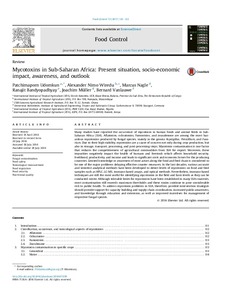| dc.contributor.author | Udomkun, Patchimaporn |
| dc.contributor.author | Wiredu, Alexander N. |
| dc.contributor.author | Nagle, Marcus |
| dc.contributor.author | Bandyopadhyay, Ranajit |
| dc.contributor.author | Müller, Joachim |
| dc.contributor.author | Vanlauwe, Bernard |
| dc.date.accessioned | 2019-12-04T11:03:51Z |
| dc.date.available | 2019-12-04T11:03:51Z |
| dc.date.issued | 2017-02-15 |
| dc.identifier.citation | Udomkun, P., Wiredu, A. N., Nagle, M., Bandyopadhyay, R., Müller, J. & Vanlauwe, B. (2017). Mycotoxins in sub-Saharan Africa: present situation, socio-economic impact, awareness, and outlook. Food Control, 72, 110-122. |
| dc.identifier.issn | 0956-7135 |
| dc.identifier.uri | https://hdl.handle.net/20.500.12478/1261 |
| dc.description.abstract | Many studies have reported the occurrence of mycotoxin in human foods and animal feeds in Sub-Saharan Africa (SSA). Aflatoxins, ochratoxins, fumonisins, and zearalenone are among the most hazardous mycotoxins produced by fungal species, mainly in the genera Aspergillus, Penicillium, and Fusarium. Due to their high stability, mycotoxins are a cause of concern not only during crop production, but also in storage, transport, processing, and post-processing steps. Mycotoxin contamination is one factor that reduces the competitiveness of agricultural commodities from SSA for export. Moreover, these impurities negatively impact the health of humans and livestock which affects household security, livelihood, productivity, and income and leads to significant costs and economic losses for the producing countries. Limited knowledge or awareness of most actors along the food and feed chain is considered to be one of the major problems delaying effective counter measures. In the last decades, various accurate and sensitive analytical methods have been developed to detect levels of mycotoxins on food and feed samples such as HPLC, LC-MS, immuno-based assays, and optical methods. Nevertheless, immuno-based techniques are still the most useful for identifying mycotoxins in the field and farm levels as they can be conducted onsite. Although tolerable limits for mycotoxins have been established in many SSA countries, most contamination still exceeds maximum thresholds and these toxins continue to pose considerable risk to public health. To address mycotoxin problems in SSA, therefore, possible intervention strategies should provide support for capacity building and supply chain coordination, increased public awareness, and knowledge through education and extension, as well as improved incentives for management of respective fungal species. |
| dc.description.sponsorship | Federal Ministry for Economic Cooperation and Development, Germany |
| dc.description.sponsorship | International Fund for Agricultural Development |
| dc.format.extent | 110-122 |
| dc.language.iso | en |
| dc.subject | Fungal Contamination |
| dc.subject | Food Safety |
| dc.subject | Food Security |
| dc.subject | Nutritional Quality |
| dc.subject | Aflatoxins |
| dc.subject | Mycotoxins |
| dc.title | Mycotoxins in sub-Saharan Africa: present situation, socio-economic impact, awareness, and outlook |
| dc.type | Journal Article |
| dc.description.version | Peer Review |
| cg.contributor.crp | Climate Change, Agriculture and Food Security |
| cg.contributor.affiliation | International Institute of Tropical Agriculture |
| cg.contributor.affiliation | Savanna Agricultural Research Institute, Ghana |
| cg.contributor.affiliation | Universität Hohenheim |
| cg.coverage.region | Africa South Of Sahara |
| cg.isijournal | ISI Journal |
| cg.authorship.types | CGIAR and developing country institute |
| cg.iitasubject | Aflatoxin |
| cg.iitasubject | Disease Control |
| cg.iitasubject | Food Security |
| cg.journal | Food Control |
| cg.howpublished | Formally Published |
| cg.accessibilitystatus | Limited Access |
| local.dspaceid | 78601 |
| cg.targetaudience | Scientists |
| cg.identifier.doi | https://dx.doi.org/10.1016/j.foodcont.2016.07.039 |

